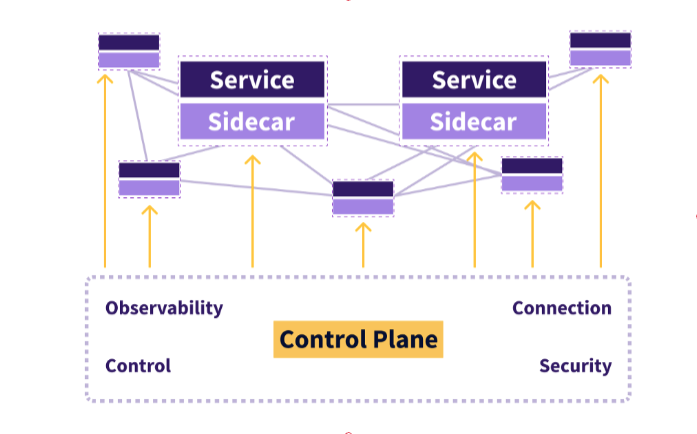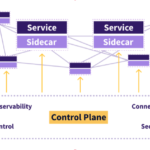Kubernetes consulting partner
What is Service Mesh in simple terms? A less technical overview


Cluster Security Kubernetes ServiceMesh
Cloud-based applications are usually a clustered collection of micro-services that are run in containers.
The increasing demand for cloud-based technology has led to large investments in the sector. Three years ago, research compiled showed that the global market for cloud technology was about $272 billion. By the end of the year 2023, this figure is expected to surge to a whopping $623 billion. There is a growing demand in this niche as individuals continue to discover its advantages. With an increasing number of applications being deployed on the cloud, the number of micro-services that run on a cloud platform increase exponentially. This creates challenges for enforcement and standardization of policies such as routing, encryption, authorization and authentication, and load balancing. Considering that a plethora of businesses rely on this technology for their day-to-day activities, such challenges need to be addressed, mitigated and eventually eradicated.
Definition
The Kubernetes service mesh is a service that is used to manage internetwork communication between micro-services in cloud architecture. Micro-services rely heavily on internetwork connectivity and communication. The service mesh is layered on top of the Kubernetes infrastructure and makes inter-service communication within the cloud architecture safe and reliable. By abstracting inter-process communication in the cloud, it allows the service mesh to separate the business logic of the application from the network and security policies of the application. This provides a top-down view of the applications and micro-services that support it.
Service Mesh is an essential tool especially when it comes to dealing with significant micro-services jobs. Platforms like Amazon and eBay usually have heavy workloads and without an effective service system, employees in this sector will have an immensely difficult time performing their duties. Using this, administrators are better equipped to manage and configure the running services in cloud architecture. Features provided by this service mesh lead to the observation, understanding and controlling of complex cloud applications throughout the entire web. If this creation was not available, individuals would be subjected to a colossal of manual work that is bound to be filled with errors. Conduction of activities in this manner would have become unsustainable over time.
Features
Service mesh is the ideal instrument for managing cloud-based micro-services. This is made possible by its features. Employment of these characteristics ensures the smooth running of cloud applications. They include:
• Linking: Through Service Mesh, services can spot each other. They can, thereafter, begin communicating regularly, establishing a business relationship that would have not been discovered otherwise. Additionally, this creation has the capability of logically routing the traffic thus monitoring its flow. It also controls the communication between endpoints through Application Programming Interface calls. Through this, heightened strategies in deployment are devised. These strategies comprise blue/green and rolling upgrades.
• Safe: Service Mesh enables its users to communicate securely. Services are equipped with the ability to accept or refute communication when approached with other services. If one feels wary towards a particular service, they can create a policy to refuse the said service access to them.
• Control: Service Mesh helps one to observe their micro-service system during distribution. Service Mesh is equipped with tools that allow services to monitor and trace activities between micro-services. These actions include; traffic stream and API dormancy. The tools applied in tracing while using Kubernetes are; Prometheus and Jaeger.
• A service mesh is also distributed in size and decentralized.
• It is managed by a control plane and data plane making the experience efficient.
• This service decreases the complexity found in operations of micro-services architecture.
• The tool avails a layer that happens to be abstract. This appears at the top of micro-services which is disseminated among diverse collections.
• The proxies are insubstantial which means that there is almost no activity when using a service mesh.
• During distribution, alternative sidecars are inserted dynamically.
Best practices
A service mesh has the distinct ability to systematize and automate communication between services. Once the user begins to employ this service, they can administer control to traffic and enjoy safety through various policies and authentication processes. Moreover, the individuals actively interacting with this tool will develop a profound comprehension of the increased micro-services present in the network. The availability of varied services in cloud applications form a complex architecture and it is bound to appear technical at some point. Observability becomes a key feature in fathoming this landscape. With that said, there are some practices one can apply while utilizing this service to gain its benefits optimally. They include;
• When one has found interest in using service mesh, they should begin applying the tool early to create time for one’s knowledge in service mesh to increase gradually. This will happen when your services architecture develops and matures.
• Lack of knowledge will lead to one implementing designs that lack uniqueness. It will also lead to the adoption of gross flaws into one’s system. The whole point of applying this service is to grow one’s business/career through inter-communication with other services. Rushing to adopt pitfalls because of a lack of know-how beats the very goal of service mesh.
• For your various micro-services present in the cloud, assign your service mesh with control over the complex architecture. This will help with the traffic, potential attacks and comprehension of the intricate landscape.
Advantages
Service mesh has become quite popular among cloud-based application users. This is due to its advantages;
• Improve the Ability to Monitor Services and Applications: Service mesh allows the monitoring and tracing of services running on a cluster. This alone increases the troubleshooting and incidence mitigation capability of the user. Using the service mesh, it is possible to break connections to bottlenecked services without making the API unresponsive. This reduces the time taken to detect and mitigate errors.
• Blue/Green Deployments: One of the advantages of Service mesh is the ability to roll out updates to a cloud application in stages without any interruption to the service. With this type of deployment, the updates can be exposed to a small number of users and once it has been validated, the updates are released to all instances. This reduces the downtime of the cloud application to almost zero. This is crucial for services that rely heavily on timeliness.
• Bridge for Legacy Applications Deployment: The major hurdle for any organization is the tedious process of migrating legacy applications to the cloud. For anybody looking to modernize their pre-existing applications, the service mesh allows you to break down the applications into different micro-services, acting as a bridge to communicate effectively without necessarily shifting the mode of communicating between micro-services. This can be easily done by cataloguing your current applications on Istio and thereafter begin moving them slowly to Kubernetes. This way, you can route your services smoothly without initiating problems in communication.
• Simplicity in API Utilization: Not having the Kubernetes applications does not mean that you cannot begin the rollout. If you desire to start using service mesh you can quantify your usage of API. If you have an Operations team they can start using service mesh early before you completely migrate to Kubernetes applications.
• Creating Production Scenarios: Since you can insert delays using service mesh, you can monitor flaws in strong deployments.
• Offers Safety to Services: Monolithic applications are commonly secured by only one address. Monolithic operations turn into micro-services and become quite vulnerable to attacks from hackers. Micro-services increases web traffic attracting hackers. Service meshes assist their users to stay secure while establishing a relationship with other services. This tool offers the validation of services, the encoding of traffic and the freedom of users to create policies that protect themselves. For instance, Istio allows its users to monitor keys and certificates. This way, you have the capability of monitoring every service during distribution. Services will, therefore, be able to assess one another and adopt effective policies around accessibility.
Disadvantages
The pros of this particular service are overwhelmingly compelling. Despite this, some disadvantages tailor service meshes. They include:
• This type of service comes at an additional cost to the organization that is using it. The service mesh in use has distinct features available to each service provider. More useful tools come at increased costs to the party using them.
• A service mesh can be quite complex especially when elements such as representations and sidecars are added to this sophisticated tool. This increases the difficulty in which individuals carry out developmental operations.
• This service requires one to have a wide range of skills in the service mesh. This essentially means that an organization will be required to employ individuals who are experts in this field. This can be costly. It can also lead to a shift in culture within the workplace since the organization will be forced to release the employees who lacked the needed expertise. Training current employees to learn about a service mesh (Istio) and an orchestrator (Kubernetes) will also be costly for the enterprise.
• At times service meshes can be quite slow as they are a complex piece of technology. Its invasive nature can lead to an architecture becoming quite slow. This defies the logic of the tool since it is meant to be reliable in the event of communication between micro-services
• The intrusive nature of service measures creates a situation where developers and operators are required to conform to a significantly opinionated platform. Here, they are forced to abide by the rules availed. Service meshes are an integral part of our current technologically advanced reality. This service offers various solutions to bridles arising from a cluster and complex micro-services landscapes. It smoothens communication between services by creating an automated and even environment. A service mesh has features that help keep its users secure. The service also assists in routing traffic, effective communication, balancing workload and fixing service pitfalls. Micro-services within cloud-based applications can now, therefore, exist without challenges that arise from the increment of virtual transactions.
Thanks for reading.
Kindly,
Interas Labs



